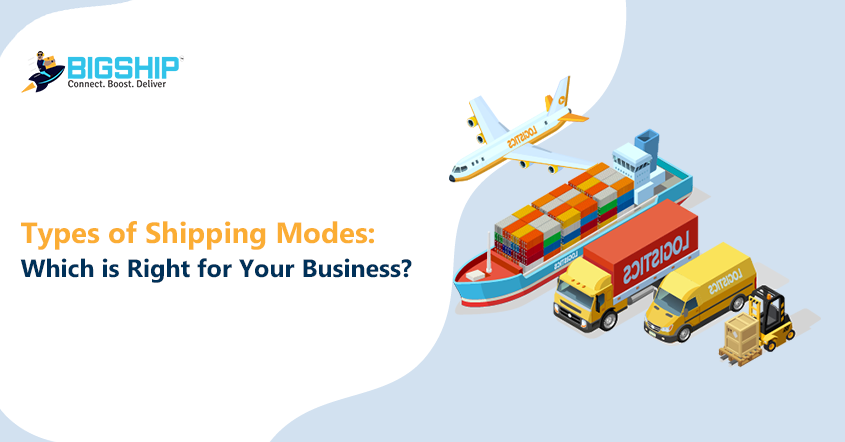Types of Shipping Modes: Which is Right for Your Business?

Contents:
1. Air Freight
2. Ocean Freight
3. Rail Freight
4. Road Freight
5. Factors to Consider When Choosing a Shipping Mode
6. Conclusion
Selecting the appropriate shipping mode is of great importance for e-commerce businesses engaged in cargo transport or international freight shipping. It not only affects operational costs but also impacts customer satisfaction and competitiveness. Understanding how different shipping modes align with diverse business needs is crucial for optimizing logistics strategies.
In this blog, we delve into various modes of freight transport, including air, ocean, rail, and road. Each mode offers distinct advantages and drawbacks, catering to different cargo types, distances, and delivery timelines. By exploring the details of each mode, businesses can make informed decisions suitable for their specific requirements.
Air Freight
Air freight refers to the transportation of goods via airplane. This mode offers swift and efficient delivery solutions for e-commerce businesses across various industries. Air freight mode of shipping is characterized by its unparalleled speed and reliability which makes it ideal for time-sensitive shipments. With air freight, businesses can ensure the timely delivery of their products to customers worldwide, enabling them to meet demanding deadlines and maintain high levels of customer satisfaction.
Power Your E-commerce Growth with Bigship
Your trusted partner for ecommerce brands of all sizes.
Advantages of Air Freight
Swift delivery: Air freight is the fastest mode of transportation as it reduces transit times significantly.
Excellent connectivity: Businesses can reach remote or distant locations with ease due to the extensive network of airlines.
High security: Air freight is highly secure, with stringent safety measures in place to protect valuable cargo.
Disadvantages of Air Freight
Higher cost: Air freight tends to be more expensive compared to other shipping modes like ocean, road, or rail.
Limited capacity: During peak seasons or high-demand periods, air freight capacity may be limited, potentially causing delays in shipping schedules.
Despite these drawbacks, air freight is well-suited for online businesses requiring fast and reliable transportation of goods, particularly those dealing with perishable or high-value products. Industries such as electronics, pharmaceuticals, and fashion often rely on air freight to meet their stringent delivery deadlines and maintain supply chain efficiency.
Ocean Freight
Ocean freight, or sea freight, refers to the transportation of goods via ships across oceans and seas. It is one of the oldest and most widely used modes of international freight shipping. It is a cost-effective cargo shipping solution for all e-commerce businesses worldwide. Ocean freight is characterized by its ability to handle large volumes of cargo efficiently over long distances.
Industries producing large or heavy items such as machinery, automobiles, or construction materials can benefit from the affordability and capacity of ocean freight. Online retails involved in import and export activities often rely on ocean freight to move goods between countries efficiently.
Advantages of Ocean Freight
Cost-effective: Ocean freight is generally more economical than air freight, making it suitable for businesses looking to minimize transportation expenses.
High capacity: Ships have large carrying capacities and allows online businesses to transport bulky or heavy goods in large quantities.
Global reach: Ocean freight enables e-commerce businesses to access markets worldwide by facilitating international trade and expansion opportunities.
Environmentally friendly: Compared to air freight, ocean freight has a lower carbon footprint, making it a more sustainable shipping option.
Disadvantages of Ocean Freight
Longer transit times: Ocean freight typically takes longer than air freight, resulting in slower delivery times, especially for time-sensitive shipments.
Weather and natural hazards: Ships are susceptible to weather conditions and natural hazards, which can sometimes cause delays or disruptions in shipping schedules.
Rail Freight
Rail freight utilizes trains to transport goods over long distances, often within a country or region. It relies on established railway infrastructure, including tracks, and terminals, to facilitate the movement of cargo. Rail freight can handle a wide range of goods, from raw materials to finished products, making it a versatile shipping option. Online businesses involved in the extraction or production of bulk commodities such as coal, minerals, or agricultural products can benefit from the cost-effectiveness and capacity of rail freight.
Advantages of Rail Freight
Affordable: Rail freight is often more economical than other shipping modes, particularly for long-distance transportation.
High capacity: Trains have significant carrying capacities, allowing for the efficient transport of large volumes of goods in a single journey.
Reduced emissions: Rail freight produces fewer greenhouse gas emissions compared to road transport, making it a more environmentally friendly option.
Reliability: Railways are known for their reliability, offering consistent transit times for cargo shipments.
Disadvantages of Rail Freight
Limited accessibility: Rail freight is restricted to areas with existing railway infrastructure, which may limit its accessibility, especially in remote or rural areas.
Dependence on schedules: Rail freight schedules are predetermined and may not always align with businesses’ specific shipping needs.
Road Freight
Road freight involves the transportation of goods via trucks or lorries on roadways. It is a versatile and widely used mode of shipping and provides flexibility and accessibility for businesses across various industries. Road freight relies on trucks or lorries to transport goods from one location to another. It offers door-to-door delivery services, allowing for direct access to both urban and rural areas. Road freight can accommodate a wide range of cargo types, including perishable goods, manufactured products, and raw materials.
Advantages of Road Freight
Flexibility: Road freight offers flexibility in terms of scheduling and routing, letting businesses tailor transportation solutions to their specific needs.
Accessibility: Trucks can reach destinations that may not be accessible by other modes of transportation, providing door-to-door delivery services even in remote areas.
Speed: Road freight can be faster than other shipping modes for short to medium-distance shipments.
Tracking and monitoring: Advanced technology allows for real-time tracking and monitoring of shipments.
Disadvantages of Road Freight
Limited capacity: Trucks have smaller carrying capacities compared to other modes of transportation like rail or ocean freight, making them less suitable for large-volume shipments.
Environmental impact: Road freight contributes to air pollution and carbon emissions, leading to environmental concerns, especially for long-distance transportation.
Factors to Consider When Choosing a Shipping Mode
When deciding on the best freight option to deliver your products, there are numerous factors to consider. Selecting the appropriate mode of transportation can lead to cost savings in shipping and logistics. Now that we’re familiar with different shipping methods, let’s explore the key considerations for choosing your shipping mode.
Cost: Cost considerations play a pivotal role. Assessing transportation expenses, including freight rates, fuel costs, and ancillary fees, helps in optimizing budgetary allocations and maximizing cost-efficiency.
Speed: Speed of delivery is equally important. Online businesses must assess transit times offered by different shipping modes to ensure timely deliveries and maintain competitiveness in the market. This assessment should consider both the nature of the goods being transported and customer expectations.
Safety: Reliability and safety are critical factors that cannot be overlooked. E-commerce businesses need to prioritize shipping modes with a proven track record of reliability and adherence to safety standards to minimize the risk of delays, damages, or accidents.
Geographic Reach: Geographic reach is another essential consideration, particularly for all businesses operating in global markets. Assessing the accessibility and coverage of shipping modes is important to ensure seamless transportation to desired destinations.
Conclusion
In conclusion, choosing the right freight shipping mode is a key decision that can significantly impact a business’s operations, costs, and customer satisfaction levels. By thoroughly considering factors such as cost, speed of delivery, reliability, safety, and geographic reach, online businesses can make informed decisions as per their specific needs and requirements.
Whether opting for air freight for its speed and reliability, ocean freight for its cost-effectiveness and global reach, rail freight for its affordability and capacity, or road freight for its flexibility and accessibility. Ultimately, e-commerce businesses must weigh these factors carefully to choose the most suitable shipping mode that aligns with their logistical priorities and supports their overall business objectives.





